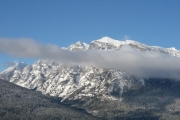Out There: Epicness in the Slocan
I love stuff that is epic. Epic music, epic stories, epic events, epic vistas – epic anything. The more epic the better. Except the Aeneid and anything by Dickens, that is. And that terrible Oliver Stone movie about Alexander the Great. But other than that, bring on the epic.
I love the Kootenays because there is tons of epicness here. Case in point, the Slocan Valley. Some of my earliest memories are of the Slocan, as it seems it was a place my parents were drawn to, too, and so we took many a day trip there. It was a place we also took a lot of our out-of-town visitors, too. One place, Sandon, has a special place in my heart, because my parents took my brother Rob and me there when we were very small. Rob was just learning to talk (which would have put me at just over three) and he couldn’t pronounce my name. But he could pronounce Sandon. So he took to calling me that, and to this day, that is his nickname for me (sometimes he shortens it to Sand, but I let him get away with it). I used to dream of the Slocan when I lived away from these parts. As an adult, the highway to from Slocan City to New Denver is nothing out of the Kootenay ordinary, but as a kid, it was terrifying–and epic. I was never afraid of heights, really, but that drive always gave me the willies, especially since there was a particularly nasty hairpin turn at a high point above the lake that used to be just one lane. You couldn’t see squat coming around that corner from either end, and the dropoff on the other side was bowel-looseningly terrifying. Once my mom crawled around that turn only to encounter a logging truck. I nearly had a heart attack. I might have been six. But that amazing look-out at the summit of that stretch made it all worth it, and that vista from up there haunted me for years, making me homesick. Apart from the Exmoor in Devon, southwest England, that viewpoint is my favourite spot in the world. I don’t get there nearly often enough to experience the epic-ness I always feel when I stare at the Valhallas from that place. Luckily, last weekend I had the opportunity. My dad and I both have a bit of cabin fever in the winter, and we often alleviate it with a road trip somewhere or other. In this case, my dad wanted to check out a craft fair and Christmas market in Sliverton, a small village of about 185 people on Slocan Lake, just minutes from the viewpoint. One might not associate a town of that size with epic-ness; however, on this particular trip, I felt like I imagine a hobbit would have while gazing up at the Mountains of Moria. No balrogs here, though! Only British Columbia’s smallest municipality. Fully incorporated and governed by a mayor and city council, Silverton nestles against the back of gigantic Idaho Mountain while being overlooked by the massive Nemo Battlements of the Valhallas. I didn’t reference the Mountains of Moria frivolously. Silverton owes its existence to mining, and even today, a crew of about eight still mines the mountain for silver–enough so that the chatty bloke who owns one of Silverton’s eateries, the Cup and Saucer Cafe, told me that the mining company, Genex, is considering bringing on board another shift of miners. I couldn’t find any corroboration for that on Genex’s site, but this coffee shop proprietor (who hails from the UK and is raising a young family in Silverton) also noted that, as is always the case with mining, it comes and goes in cycles, and even as recently as ten years ago, there were 25 miners drilling for ore there. The current driller, I learned, is a 60-year-old dude nicknamed Buffy, who has more stamina for his job than the twenty-somethings the company sometimes sends up to work with him. Like Rossland, Silverton has an epic history, and like the Mountain Kingdom, it’s proud of its mining heritage. They have a mining museum that boasts aerial ore cars still on their pulleys that hang over the front lawn of the local art gallery. There was a silver rush here around the same time Rossland had it’s gold rush, and although it’s population didn’t swell the way Rossland’s did, it was a thriving town of over 500 people with its own newspaper,The Silvertonian, six hotels, three general stores, and a druggist. It was connected to other communities along Slocan Lake by paddlewheeler. Today, in addition to the aerial ore cars at the art gallery, there are many other signs of Silverton’s history to be seen around town. The mining display consists of various bits and pieces of mining paraphernalia like the old horse drawn tram cars and some other equipment, and main street still has some original buildings. The cafe owner I spoke to also mentioned that there were some Chinese residents back in Silverton’s heyday, and he lives in a house that used to be a Chinese laundry. Silverton obviously fared better than her neighbour, Sandon, which became a ghost town after a flood in 1955, though it had pretty much been abandoned since just after WWII. Today, Silverton struggles with many of the same issues other small communities in the Kootenays do: sustainability, the fluctuating economy, and sustainable schooling (kids are now bused into New Denverm but there has been talk of busing them further afar). But as the cafe owner said, the people who live there want to live there, and they do what they can to make it work for themselves. I took about a zillion pictures of the Valhallas from the viewpoint above Slocan Lake and from Silverton. I took a similar number of photos of the lake itself; the colour and clarity of its waters always drew me in, and it still does. I felt completely enveloped in epic-ness that day, and it was almost akin from dragging myself out from under a warm duvet on a Monday morning to have to get into the car to come home in the afternoon. While driving along the highway between Silverton and Slocan City, I found myself kind of missing the old, terrifying highway. I don’t know why–this one is a thousand times safer–but I wish, as a child, I’d had a digital camera so I could have captured that corner, because it was a corner that seemed to be the gateway into another world. Epic mountains, epic drives, epic surroundings, a dose of epic history–more reasons to love living in the Kootenays!


























